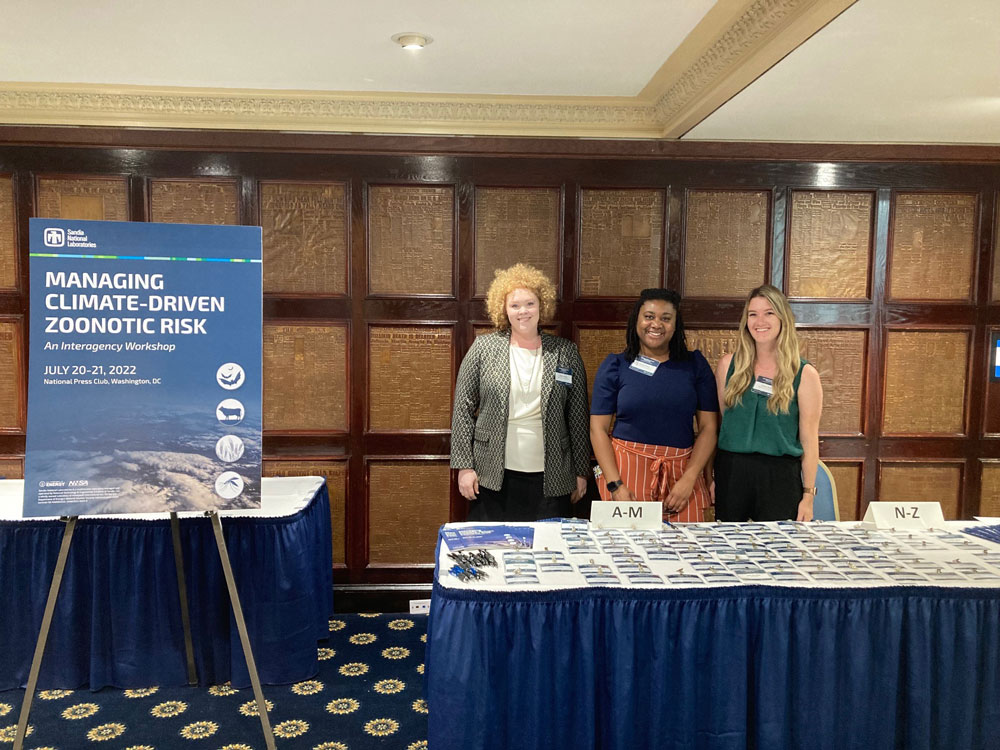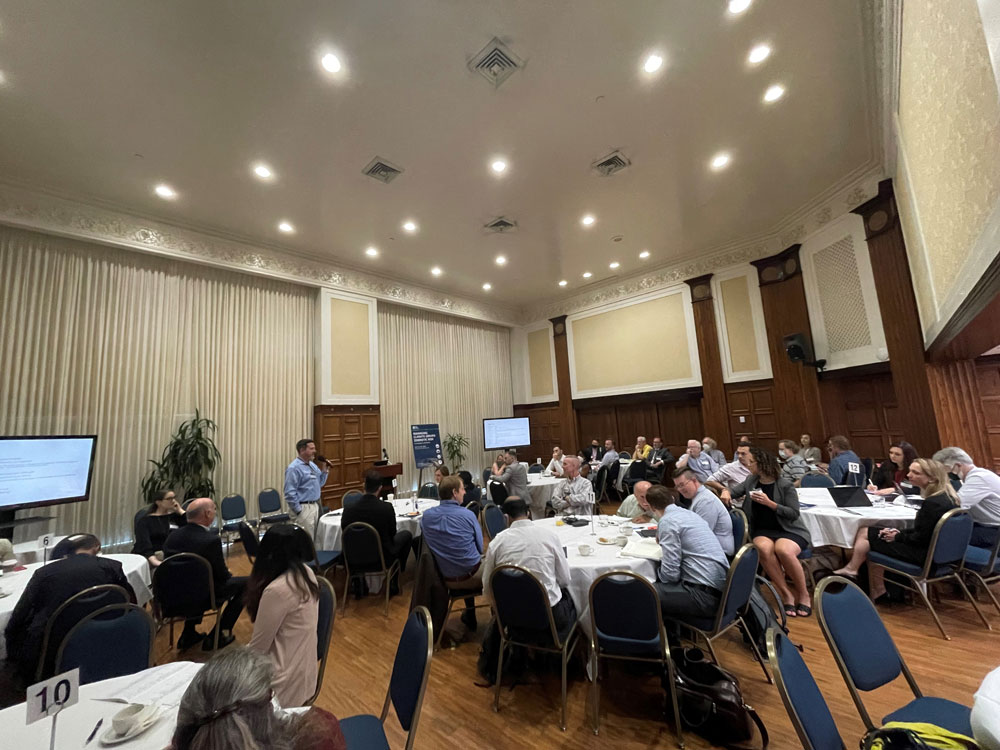Federal agencies, labs examine climate-driven zoonotic risk

Sandia biodefense program manager Cathy Branda knew the question of climate change possibly setting in motion the next pandemic occupied the minds of many federal government stakeholders. In response, she brought together stakeholders interested in discussions to chart a course for future research and collaboration.
According to the Centers for Disease Control and Prevention, an estimated 75% of emerging infectious diseases, including COVID-19, are zoonotic, meaning they spread from animals to humans. Rapidly changing environmental and social conditions driven by climate change could increase the risk of pathogens being transmitted from animals to humans, Cathy said.
Managing these climate-driven zoonotic risks was the focus of a two-day workshop organized by Cathy and a team of Sandians in July. Participants represented 11 federal agencies and six national laboratories, including Sandia, Lawrence Livermore, Lawrence Berkeley, Los Alamos, Oak Ridge and Pacific Northwest. Sandia released a report on the workshop in December.
“Everyone was excited by the idea of bringing a community together to address this,” Cathy said. “They all have their own piece of the pie, and they knew it interconnected with others.”
Sandia was well positioned to fill that integrator role as a federally funded research and development center with a mission to address homeland security by understanding and countering biological threats. The work also draws on Sandia’s capabilities in atmospheric monitoring, climate modeling and bioscience. The specific focus on climate-driven zoonoses also intersects with other strategic work across the Labs to promote climate security nationally and globally.
Spillover effects
Georgetown University assistant research professor Colin Carlson, who studies the relationships between climate change and zoonotic disease, began the workshop with his keynote address.
Carlson said researchers have underestimated the link between climate change and zoonotic spillover by focusing primarily on exposure at the animal-human interface. Climate change will also alter exposure patterns between wildlife species, he said. In the Arctic, for example, melting sea ice is causing seals to move to new areas, exposing sea lions and sea otters to a deadly viral disease.
That’s not just bad news for susceptible wildlife populations — these jumps between hosts could make it easier for viruses to reach humans. Fortunately, Carlson said, people already do many of the activities required to solve these climate-driven zoonotic risks; they just need to be more targeted with their efforts.

Anthony Falzarano, a Sandia systems analyst, saw this issue come up in various ways in reading he did to prepare for the workshop. That review, along with briefs given by federal agency representatives at the workshop, revealed the growing importance of the One Health model in recognizing the inextricable linkages between human, environmental and animal health.
“It’s a paradigm shift in how we look at these risks,” Anthony said. “You can’t address any one aspect of that triangle without addressing all of them. We need to break down the silos between government agencies to streamline and integrate detection and response.”
Cathy agreed, saying COVID-19 is an example of where a more targeted, centralized early response could have made a difference. “There’s renewed interest across agencies to get ahead of the problem, as well as concrete ideas about how to get ahead of the next pandemic. Everyone has limited resources on their own, but together you can do some pretty amazing things,” she said.
Integrating data to inform preparedness
In preparing for the workshop, Cathy also conducted more than 80 interviews with stakeholders across many different federal agencies. One common theme that came up repeatedly in interviews and the workshop was the idea of better standardization, integration and sharing of existing and future data.
“I think an ‘aha!’ moment for me was that there’s lots of data out there that people are not taking advantage of,” Cathy said.
For Cathy, this included learning about the many types of relevant data collected by the DOE national laboratories. Sandia, for example, has translated the atmospheric research capabilities developed in the 1950s for nuclear testing into a robust climate monitoring program that uses innovative technologies, such as distributed acoustic sensors and tethered balloons. Sandia also develops assays and deployable platforms that can be used to detect viruses and bacteria in people and the environment.
Improving the knowledge of and access to all this existing data can make efforts to understand risk more efficient and effective. Similarly, it makes it easier to identify actual data gaps that might require new forms of data collection.
In addition to collecting environmental and biological data, Sandia offers experience in data integration and analytics. “We have got a group working in the area of understanding how data can be integrated across disparate places to create much better disease models that actually correlate to data being collected in the field,” Cathy said.
“We are the ones who can take all this data and put it into a system-of-systems model,” Anthony said of the national laboratories. In addition to our top-notch researchers, he said, the national laboratories are a trusted source of unbiased information and innovation that could be used both by the federal government and communities to prepare for countering climate-driven zoonoses.
“The idea is that we can use these models to create tools that could be used even by under-resourced communities to respond and deal with these issues in their local jurisdictions,” Cathy said.
Catalyzing collaboration through community
One of the big successes of the workshop was the opportunity for those interested in this topic to connect and identify possible areas for coordination and collaboration, Cathy said. “We know that there’s already been some interesting connections made, and we hope that those continue to be developed.”
To keep those conversations going, Cathy and her team are planning a series of meetings to dive deeper into specific themes, such as data standardization, integration and modeling needs.
There’s also been a push to create an interagency working group to spearhead some of the challenges identified through the workshop. Anthony said this group could play an important role in building a community that brings these issues to the forefront of the global health security agenda — and to the attention of potentially interested early- to mid-career professionals.
“A lot of people don’t quite know that this space exists,” he said. “I think many lawyers would be interested in global health law and many researchers would want to do One Health research if they knew more about it. We need to show them there is a career path.”
Cathy attributed the success of the initial workshop and any follow-on efforts to the support provided by the team of research, business development, executive protocol and communications staff at Sandia. “It was definitely a team effort.”
“It was clear to me if we ran with this idea that there would be a lot of resonance across these agencies. I hope the participants saw themselves in what could become a much larger vision.”
Learn more about efforts to manage climate-driven zoonotic risk by reading the full workshop report.